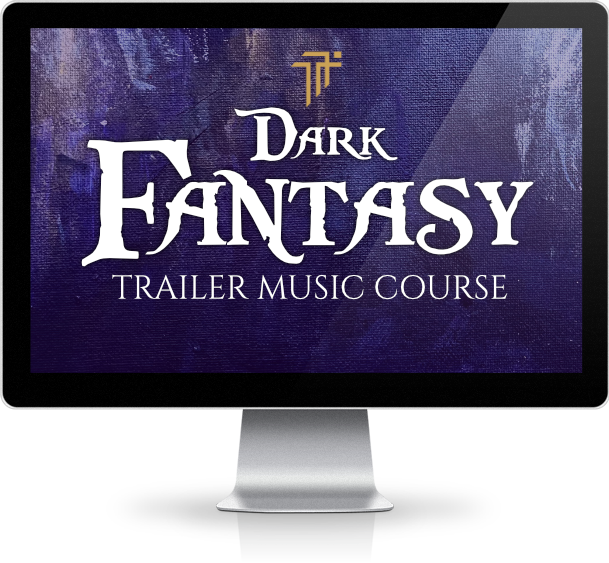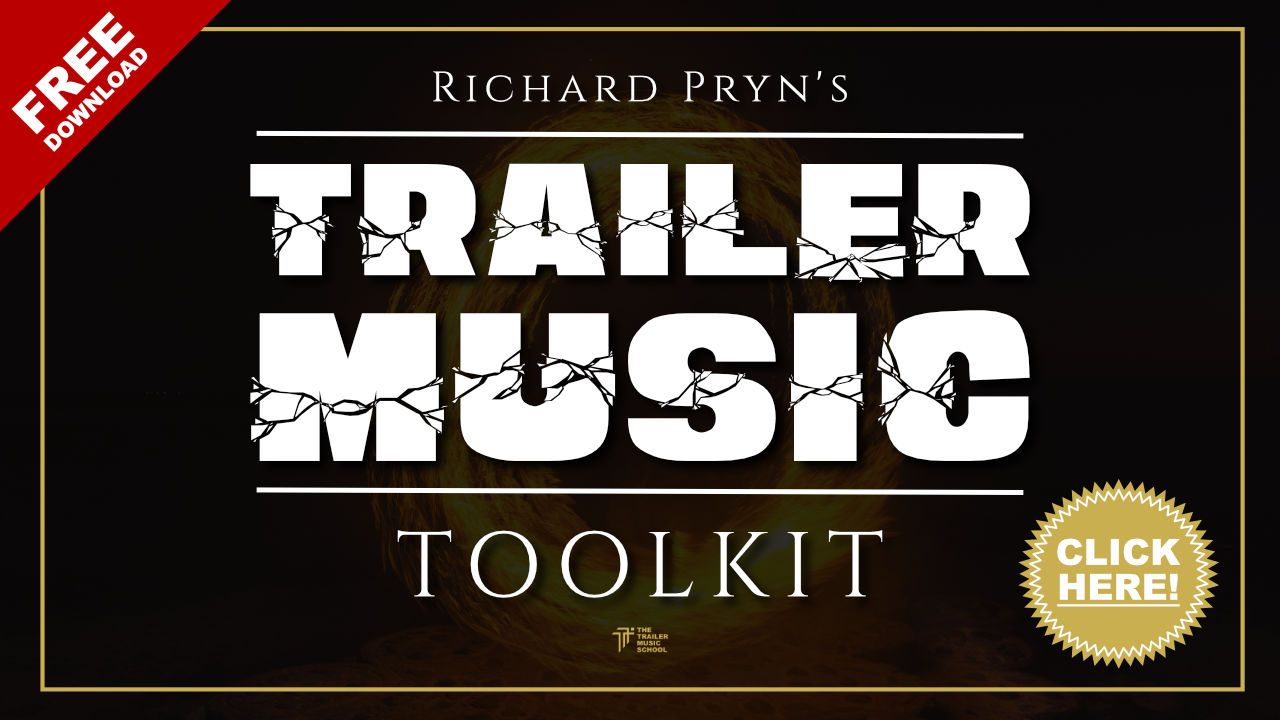[Here's the video transcript]
My track 'Thread of Time' recently landed on a trailer for the video game, The Lost Ark. They've just done an update called the 'Artist' series. And they used my track 'Thread of Time'.
In this post, I want to give you a lovely walkthrough of how I approached writing this track.
Now this track was for a dark fantasy album. So the references were as you'd imagine; dark fantasy movies. Specifically family adventure stuff.
This trailer was one of the references
So we were to use an orchestra, with tuned percussion, and choir, and really bring home all the Danny Elfman in all of us.
I really enjoy this type of writing and I really enjoyed writing this track.
As a result of writing these tracks, I actually produced a course called Dark Fantasy, just to show people how to write this type of music for movie trailers.

Dark Fantasy Trailer Music Course
This course covers the theory and music production required to create a piece of dark fantasy music for movie trailers.
I'm gonna show you the track first and then I'm gonna break down exactly how I wrote it. So let's check it out.
That is my cue, it's working title was The Thread of Time. The track name was changed to Gremlin.
Starting the Track
So my approach was very straightforward and it starts with either tuned percussion or short strings because I wanna establish the pattern and the harmony.
I wanted it to be in a minor key because I wanted it to be dark, obviously. So I've started this in C minor.
I also wanted it to be pacey.
A nice way to do a pacey track is to put in 6/8 because it gives it this lovely galloping feel, a natural sense of drive to your cue without really having to do too much.
Patterns in threes; 1 2 3, 1 2 3, 1 2 3, 1 2 3. give a great sense of movement
So I was like, "Okay, I'm gonna be in 6/8 and C minor."
Perfect.

Choosing the Chord Pattern
I just wanted to come up with a chord sequence that was quite fast-moving 'cause I wanted this to feel fast.
This was the whole idea - I'm gonna really hammer home that point that I wanted this to feel quite fast.
Let's have a listen to this 'cause this was the starting point for the track.
You'll notice the use of B natural In the key of C minor. So rather than just going C minor to
F minor, which would be the natural minor key. So I thought, "okay, you know what? I'm gonna check in a few other elements here to make it feel like a major cue, but give it a dark feeling."
I've raised the, A flat up to A, to give us F major. And then I raised the B flat up to B to give us G major.
C, D E F G A B C. So with the natural sixth and natural seventh, it gives it this lift, like the Dorian having the natural sixth or the harmonic minor having the natural seventh within a minor scale, it just lifts it.
And that was what I wanted to achieve with this, yes, I'm going minor and dark, but I'm gonna be using a different mode to give me different effects and that's the key to this type of writing. This kind of dark fantasy stuff. You explore different modes and scales.
I chose the Melodic Minor Scale.
If you can start to explore modes and scales and start to borrow notes and chords from other keys then all of a sudden you expand your composing vocabulary that much more.
My general idea with this was to say, "If I'm going to work with this chord pattern, I'm gonna use this for the first like 40 seconds."
And it's just about expanding the orchestration.
So if you listen, it starts with the Celeste and then the choir and the short strings just double up. The short strings are literally just doubling and the choir is just picking the top notes. Also, the woods are just picking out that movement of the choir, but lower down. It's really nice to be able to use woodwinds.
It works so well and is a huge time saver, simply orchestrating your idea gradually. It's kinda like Carmina Burana.
So often in trailers, we chuck the woodwinds out the window, but in this style, you can chuck in all the woodwinds you want and it's lovely. I really love woods. So it's really nice to hear them and use them.
That was basically my act one. I'm setting the scene, nothing's getting massive I'm not even really using any massive drum hits or anything.
And then we roll into.
Make A Change in Act 2
So this is a tactic I like to utilize a lot, which is compressing and expanding the chords.
Each chord was one bar. Now I've expanded each chord to be two bars. And that gives me a chance to introduce this " Pirates of the Caribbean swashbuckling melody that was the plan anyway.
I just kept that idea of this quite a percussive melody line. That would bounce off of the cello's string really nicely and sound really fat when it was played by the brass.
So I've given that, like that kind of moving chord phrase to the short strings, the pianos, the woodwinds. The choirs and then.
Giving it to the brass and throwing the choir up. So throwing them into the air. So as you can see, this is such an easy win. When writing, make your track feel like it's progressing. Just take the idea and put it up an octave. It gives the sense of growth and building without having to think of any new ideas.
Hold On to The Ending
This is the thing I often talk about where you just repeat the last chord, the last motif, or the last drop.
You just repeat it so it's almost like your vinyl has gone on the loop which creates tension.
You're like, "oh, it's not ending. That's not the ending. Damnit, Why is it not ending?"
And then it ends, you go, "Ahhhhhhhh".
Tension and release.
Change it Up for Act 3
Okay. I've established my chord sequence in act one and two, but I want it to feel like it's changed in Act three. So instead of continuing the same idea, I introduce a new chord sequence. That gives me a chance to bring in growth and development.
The new idea is not anything complicated, I have changed from the melodic minor to the natural minor to allow a new feeling to the last act.
I also wanted to bring in one of my heroes here, Philip Glass-inspired arpeggios.
You can hear I've gone from Danny Elman and I've switched to Philip Glass because this type of writing lends itself beautifully to fantasy drama.
I took my initial pattern that revolved around threes - 1, 2, 3 1 2 3 to a pattern that revolves around sixes - 1 2 3 4 5 6, 1 2 3 4 5 6 etc.
Expanding the number in your pattern from a three to a six opens the pattern out. And that's what we wanna do in act three. We wanna feel like it opens out.
There are only really two ideas going on here; the arpeggio, and then the harmony-based melody.
I'm using notes from the harmony to create a sense of melody. A massive easy win there.
I'm just also using the drums and cymbals to accent the bars to make clear edit points for the trailer editor.
What are your takeaways from this?
1. To explore modes and scales.
If you are writing dark fantasy, explore modes, explore different notes within a scale, and different chords within a harmony. Try it, and there's no, one's gonna tell you off. If you switch between major and minor chords, either.
The Beatles did it all the time. They championed that, starting with a minor root chord and then shifting to a major and vice versa.
That gives us new and exotic sounds and feelings. Which is what this stuff needs to bring. It needs to bring something new and exotic. It's fantasy. It needs to feel otherworldly. And that's how we do it here.
2. Use orchestration to your advantage
The cannon of film music, which then built up to Danny Elman's, Fantastic scores for so many dark fantasy movies have given us this language of using tune percussion and woodwinds and pizzicato strings, which obviously comes back to the cannon of silent movies with a player piano.
In this instance that sound palette with those modes. All of a sudden [00:19:00] puts you in this world. So a lot of the work is already done for you.
3. You can take a simple idea and just roll with it.
Just act one. Play it like this act two, give us a variation of that same idea, act three.
Give us another variation of that same idea. And then when you go through those, you can explore different patterns. 1, 2 3 1 2 3 1 2 3 1 2 3 1 2 3 4 5 6 1 2 3 4 5 6 1 2 1 2 1 2 1 2 1 2 1 2. By doing that, you start to explore the effects of pace. And expansion that is induced by these patterns changing like that.

Get my FREE Trailer Music Toolkit
It contains all the One-shots you need to sketch a complete track, and the hugely popular Perfect Trailer Music Cue Blueprint PDF.






